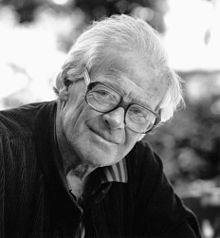Ralph Erskine (architect)
| Ralph Erskine | |
|---|---|

Ralph Erskine (1987)
|
|
| Born |
24 February 1914 Mill Hill, London |
| Died | 16 March 2005 (aged 91) Drottningholm, Sweden |
Ralph Erskine, CBRE, RFS, ARIBA (24 February 1914 – 16 March 2005) was a British-born architect and planner who lived and worked in Sweden for most of his life.
Erskine was born in London in 1914, and spent his childhood in Mill Hill in the London Borough of Barnet (North London). His parents were socialists, adherents of the Fabian Society, which promoted the idea of the evolution of Britain into a socialist state.
His Scottish father was a Presbyterian minister, but his parents sent him to the Friends School Saffron Walden (1925–1931), a Quaker school, probably because of their socialist beliefs. There, he became committed to the Quaker ideals, which laid the foundation for his views on society, man's place in it, and on architecture.
During the 1930s, Erskine studied architecture for five years at the Regent Street Polytechnic, London under the direction of Thornton White. At the time, White's curriculum required the study of classical architecture before students were free to follow their own ideas. One of his fellow students was Gordon Cullen who would become a well-known architectural illustrator, urban designer and theorist. Cullen advocated the improvement of urban settlements through an understanding and analysis of their picturesque qualities. This approach was profoundly influential on Erskine, who insisted in his work that the context and landscaping of his buildings be carefully integrated.
After qualifying as an architect Erskine began work with the design team for Welwyn Garden City under the leadership of Louis de Soissons. He studied town planning and this interest broadened his approach to architecture, in particular about how buildings related physically and socially to their setting. In 1936 he became an associate of the Royal Institute of British Architects.
Before the outbreak of World War II, Erskine travelled to Sweden. He was attracted there partly by his admiration for the work of the Functionalist Swedish architects Gunnar Asplund, Sven Markelius and Sigurd Lewerentz and partly by the country's adoption of the social welfare model. In Sweden the political will was reflected in the national architecture and these two factors coincided with his own humanist beliefs. He would go on to make an important contribution to the architectural landscape of both his adopted country and to that of England.
...
Wikipedia
